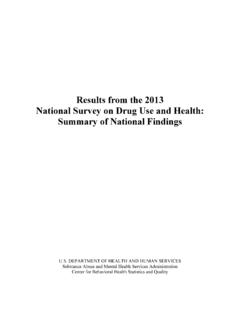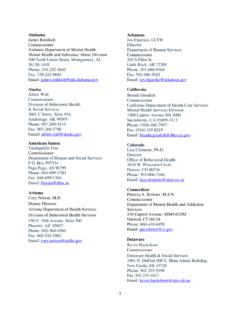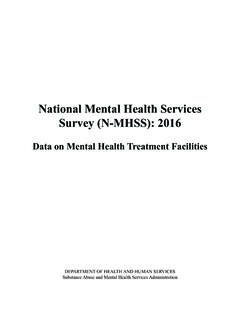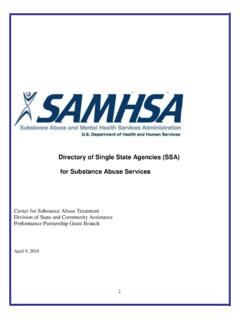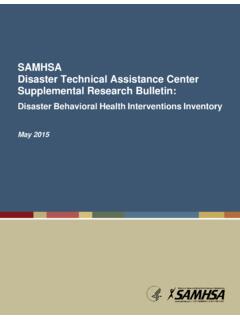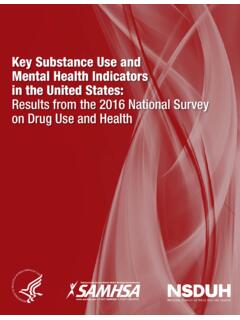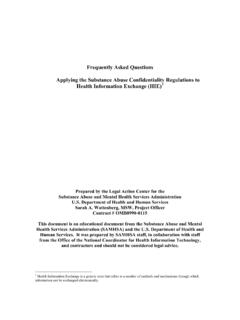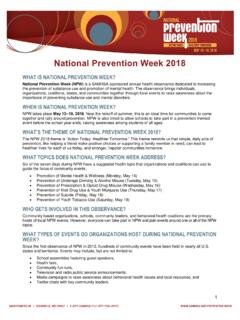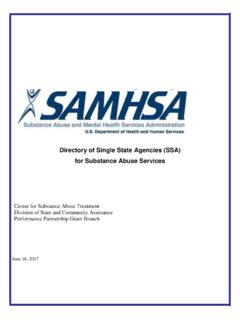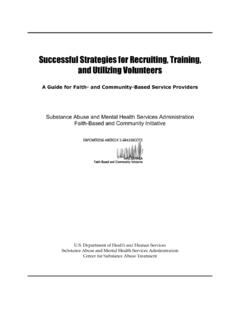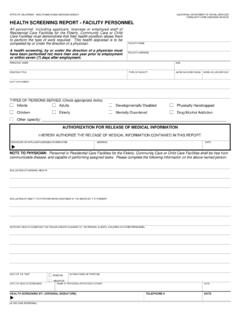Transcription of Ready, Set, Go, Review: Screening for Behavioral Health ...
1 Ready, Set, Go, Review: Screening for Behavioral Health Risk in Schools Acknowledgements This report was prepared for the Substance Abuse and Mental Health Services Administration (SAMHSA) under contract number HHSS2832017000751/HHSS28342001T with SAMHSA, Department of Health and Human Services (HHS) in consultation with John Kelley, Nadine Benton served as Contracting Officer Representative. Disclaimer The views, opinions, and content of this publication are those of the author and do not necessarily reflect the views, opinions, or policies of SAMHSA or HHS. Nothing in this document constitutes a direct or indirect endorsement by SAMHSA or HHS of any non-federal entity s products, services, or policies, and any reference to non-federal entity s products, services, or policies should not be construed as such.
2 Public Domain Notice All material appearing in this publication is in the public domain and may be reproduced or copied without permission from SAMHSA. Citation of the source is appreciated. However, this publication may not be reproduced or distributed for a fee without the specific, written authorization of the Office of Communications, SAMHSA, HHS. Electronic Access This publication may be downloaded at Recommended Citation Substance Abuse and Mental Health Services Administration: Ready, Set, Go, Review: Screening for Behavioral Health Risk in Schools. Rockville, MD: Office of the Chief Medical Officer, Substance Abuse and Mental Health Services Administration, 2019. Originating Office Office of the Chief Medical Officer, Substance Abuse and Mental Health Services Administration, 5600 Fishers Lane, Rockville, MD 20857. Published 2019. Nondiscrimination Notice SAMHSA complies with applicable Federal civil rights laws and does not discriminate on the basis of race, color, national origin, age, disability, or sex.
3 SAMHSA cumple con las leyes federales de derechos civiles aplicables y no discrimina por motivos de raza, color, nacionalidad, edad, discapacidad o sexo iii Forward In 2003, the President s New Freedom Commission on Mental Health concluded that America s mental Health service delivery system was in shambles. The Commission s final report stated that for too many Americans with mental illnesses, the mental Health services and supports they need remain fragmented, disconnected and often inadequate, frustrating the opportunity for recovery. A number of the recommendations of the President s New Freedom Commission on Mental Health were not implemented or have only been partially realized. Since then, quality of life has not fundamentally changed for adults with serious mental illnesses (SMI) and children and youth with serious emotional disturbances (SED) and their families in the United States.
4 -The Way Forward (2017) Students are routinely screened for physical Health issues ( , vision, hearing). However, emotional or Behavioral Health issues are generally detected after they have already emerged. It is time for that to change. The Ready, Set, Go, Review: Screening for Behavioral Health Risk in Schools toolkit is designed to guide schools through the process of developing comprehensive Screening procedures, as well as provide readily available resources to facilitate the implementation of effective Behavioral Health Screening in schools. iv Contents 1. 2. Chapter 1: 3. Chapter 2: 4. Chapter 3: 5. Chapter 4: 6. v Introduction Fairhaven School District is a mid-sized suburban district. Students in Fairhaven are generally high achieving, but they are not immune to typical challenges faced by many students within their state and across the nation.
5 The superintendent of schools, Dr. May, is concerned with educating the whole child and recognizes the importance of addressing educational factors which impact upon students success in school beyond the traditional curriculum and academic influences. She wants to build upon students strengths and help them develop social and emotional life skills, while also identifying students who present risk factors associated with adjustment difficulties that may be related to Behavioral or psychological problems. Dr. May recognizes that both these factors (social and emotional skills and Behavioral Health risk factors) influence a student s performance in the classroom. While Fairhaven is like other school districts which have limited fiscal and staff resources, Dr. May has prioritized these issues as part of the District s strategic plan. She has worked with families in the district to make this a priority and has even used student focus groups to gain their perspective.
6 However, she is unsure of where to start or how to prepare the development of a comprehensive plan that will help the district accomplish these goals. Screening is a Component of a Comprehensive Systems Framework School administrators like Dr. May often recognize the importance of addressing social and emotional needs of students. In fact, a recent internal survey conducted by the School Superintendents Association indicated that students Behavioral Health needs were the top concern of superintendents across the country (K. Jackson, personal communication, June 25, 2018). Research conducted by The Collaborative for Academic, Social, and Emotional Learning 1 (CASEL) identified social and emotional factors as the most powerful influence over students achievement in school (CASEL, 2003). Students come to school each day with more than their lunch and backpack.
7 They bring life factors that shape their learning and development. These influences range from family issues, Health concerns, and culture of origin to behavior, learning profiles, and abilities. Virtually all have the potential to impact the mental Health of students. Although historically mental Health has been viewed through the lens of mental illness ( , depression, anxiety, etc.), society has come to recognize that good mental Health is not simply the absence of illness, but also the possession of skills necessary to cope with life s challenges. As education professionals, school staff need to understand the role mental Health plays in the school context because it is so central to our students social, emotional, and academic success. Research estimates that one in five students will experience a significant mental Health problem during their school years.
8 These issues vary in severity, but approximately 70% of those who need treatment will not receive appropriate mental Health services (Perou, et al., 2013). Failure to address students mental Health needs is linked to poor academic performance, behavior problems, school violence, dropping out, substance abuse, special education referral, suicide, and criminal activity (Darney, Reinke, Herman, Stormont, & Ialongo, 2013; Hawton, Saunders, & O Connor, 2012). These issues may seem foreign to elementary school, but mental Health concerns can develop as early as infancy, and, like other aspects of child development, the earlier schools address them, the better. Family is the first source of support for a child s mental Health . However, the increased stress and demands of life today make it imperative that schools partner with families to help students thrive.
9 Indeed, schools are excellent places to promote good mental Health . Students spend a significant amount of time in school and educators can observe and address their needs. Doing so 2 effectively requires developing the capacity both to reinforce students natural mental Health strengths and to respond to students suffering from the more acute mental Health disorders that are on the rise today. However, school leaders often lack the information needed to implement effective comprehensive school-wide Behavioral Health services. Despite the lack of information for these comprehensive services, many school districts have elements of a tiered system of support in place as part of their overall student support programs ( , building level support teams, data-based decision making, school-wide bullying prevention and interventions, positive Behavioral interventions, counseling services, etc.)
10 These elements can serve as the basis for the development of a comprehensive Multi-Tiered Systems of Support (MTSS) to address Behavioral Health needs of students. MTSS can serve as the framework to provide universal programs to help all students develop critical social and emotional skills, as well as provide school-wide approaches to teach appropriate Behavioral skills and manage problem behaviors. MTSS also includes the provision of targeted services for students displaying the emergence of problematic behaviors and emotions, as well as intensive services for students with chronic psychological issues or maladaptive behaviors. Effective elements of MTSS include the use of student data to screen for risk or the potential development of social, emotional, and Behavioral problems. Data are also used to help make decisions on when students may need additional supports beyond the universal interventions provided to all students, to monitor the effectiveness of certain programs, as well as measure the progress of individual students.
